 |
























|
 |
 |
|
author:
|
Inverness Research Associates
|
|
submitter:
|
Mark St. John
|
|
description:
|
This is one of three reports (Including The
Contributions of Teacher Leaders and The Work of
Teacher Leaders) wrriten by Inverness Associates
on the California Subject Matter Projects (CSMP).
"The CSMPs consist of nine Projects providing
professional development in nine different
disciplines...at 101 regional sites--all of which are
designed to attract, develop, nurture, sustain, and
promote teacher leadership."
This report examines the scale and nature of CSMP teacher leadership statewide and assesses the work of individual sites in determining the degree that they were successful in developing and deploying teacher leaders.
|
|
published in:
|
Inverness Research Associates
|
|
published:
|
1999
|
|
posted to site:
|
01/14/1999
|
EXECUTIVE SUMMARY
Background
The California Subject Matter Projects (CSMPs) are a statewide professional development initiative comprised of nine projects and 101 regional sites. The raison d’être of the CSMPs is teacher leadership. Modeled on the successful tenets of the California Writing Project, the CSMPs simultaneously support the development of and draw upon the expertise of teacher leaders.
The teacher leadership that is developed and supported by the CSMPs can be seen to have influence in three different spheres:
Spheres of Influence for CSMP Teacher Leadership

- In the first sphere the CSMPs draw upon the teachers in their sites' "teacher leadership pool" to help conduct the institutes and workshops offered by the sites.
- In the second sphere CSMP teacher leaders provide district and school-based professional development activities as part of contracts or agreements that are established between local CSMP sites and nearby districts.
- In the third sphere CSMP teacher leaders engage in a wide range of leadership activities that have no formal connection with the CSMPs (e.g. they provide workshops at professional meetings, serve on school restructuring teams, or lead curriculum development projects).
In order to more fully understand the degree to which and the ways in which CSMP teacher leaders are working in each of these spheres, we designed a survey that asked CSMP teacher leaders detailed questions about the totality of their teacher leader activities over the past several years. In the spring of 1996 we distributed these surveys to Site Directors and asked them, in turn, to send a survey to all the teacher leaders "active" at their sites.1 Ultimately, we received 1,313 completed surveys.2
The more than one thousand teacher leaders in our sample represent 88 sites (i.e. 91 percent) of the 97 CSMP sites operating at that time and three percent of the approximately 48,000 individual teachers who participated at CSMPs in 1994-95. 3
This sample also represents 15 percent of the estimated 8,700 teacher leaders that Site Directors report were active at their sites that year.4 At least 40 percent of the teacher leaders who received the survey returned it.5 We presume that they represent, on the whole, teachers who are among the most involved and committed teachers in their leadership pool.
Major Findings
In this Executive Summary we briefly discuss the major findings that emerge from the survey data.
CSMP sites tend to develop and sustain relationships with a core group of teacher leaders over a period of many years.
- Two-thirds of the teacher leaders responding to our survey have been actively engaged with a CSMP site on a regular and continuing basis.
- CSMP teacher leaders are typically involved with their sites for five years or longer. Those assuming leadership roles at the site typically hold those roles for four or more years.
- There is considerable movement and "cross-over" between Project sites by active teacher leaders. Almost half (45 percent) of the teacher leaders have attended institutes or other activities at other sites of the same Project that sent the survey to them, and over a quarter (28 percent) have played a leadership role for another site of their Project. Over a third (37 percent) of the teacher leaders have attended activities at another Project and one in five (20 percent) has played a leadership role for another Project.
Through their teacher leaders, the CSMPs have had a presence in schools, districts and counties throughout the state.
As noted in our Summary of Evaluation Findings,6 the CSMP teacher leaders are part of a substantial "infrastructure" for professional development in the state.
- Collectively, the 1,313 teachers included in our survey sample are providing professional development to 16 percent of the state's schools, 43 percent of its districts, and 95 percent of its 58 counties. We estimate that these teacher leaders work with roughly 15 to 30 percent of the state’s teachers each year, and that they personally teach one to two percent of the state’s students each year.
- These teacher leaders spend an average of a day each month in independent (non CSMP-affiliated) leadership roles.
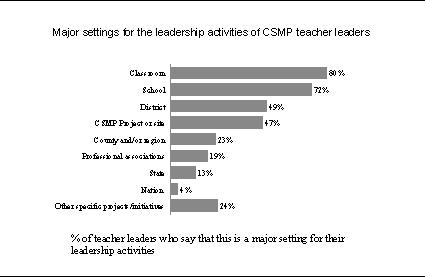
Percentages represent teachers who selected 4 or 5 on a 5-point scale where 1 = "Not a part of my leadership activities" and 5 = "A major part of my leadership activities."
The CSMPs support teacher leadership in multiple venues, but the teacher leaders' work is especially concentrated at the level of the classroom and local school.
Most of the leadership provided by teacher leaders has the potential to benefit students and other teachers who are not CSMP participants themselves.
- Half of the teacher leaders carry out their leadership roles mostly in schools, districts, and settings other than the CSMP sites.
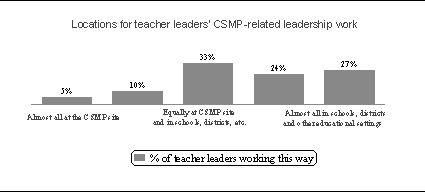
- The majority of teacher leaders who responded to our survey are leaders in local efforts to improve their own schools. Over half of the responding teacher leaders are also working with schools other than their own.
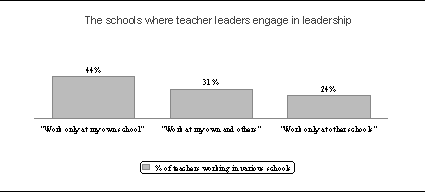
- Along with other leadership roles they play in schools, about 40 percent of the respondents are engaged by their local CSMP site to provide contracted professional development activities to local schools and districts.
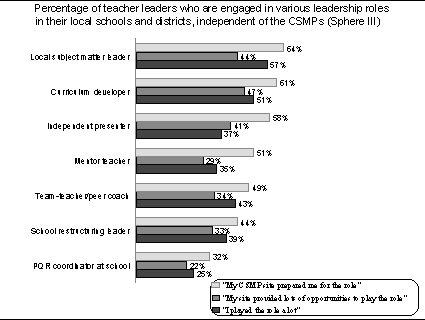
Percentages represent teachers who say that they have been prepared by their CSMP site to play a role, that the site helped provide them opportunities to play the role, and that they have played the role to a great extent in the last 12 months (i.e. gave a rating of 3 on a 3-point scale where 1 = "not at all" and 3 = "a lot").
The CSMP teacher leaders are engaged in leadership work in schools and districts that reflect the broad spectrum of students in the state.
- Teacher leaders in our sample listed 850 public schools by name in which they had worked with other teachers. These schools appear to be representative of the state’s schools overall in terms of student ethnicity and socioeconomic status. The teacher leaders in the survey sample may slightly over-represent suburban schools and under-represent rural schools.
- Through their teacher leaders, the CSMPs have a presence in all 44 of the state’s large "highest-needs"7 districts. CSMP teacher leaders in the survey sample are providing formal or informal professional development in each of these districts.
- Los Angeles is the "most served" district, with 116 teacher leaders. The ten districts served by the largest numbers of teacher leaders include seven highest-needs districts.
The Ten Districts Which are Served by the Most CSMP Teacher Leaders
| District |
N of Teacher Leaders |
District |
N of Teacher Leaders |
| Los Angeles USD |
116 |
Fresno USD |
24 |
| Sacramento USD |
46 |
San Juan USD |
23 |
| San Francisco USD |
42 |
Davis Joint USD |
21 |
| Elk Grove USD |
29 |
Woodland USD |
20 |
| San Diego City USD |
29 |
Chico USD |
19 |
The CSMPs, when judged by the responses of these 1,313 teacher leaders, appear successful in their efforts to develop teacher leadership and, simultaneously, to engineer multiple opportunities for teachers to assume both internal and external leadership roles.
- About one-half of the responding teacher leaders believe that leadership roles at the site are open to them if they wish to pursue such work.
- Teacher leaders assume a wide number of roles which have them working in a leadership capacity, in site-sponsored leadership roles, for an average of one day per month.
- A significant number of the teacher leaders (41 percent) are actively engaged in the design and implementation of the activities at the CSMP site.
- Seventy-five to 85 percent say that the sites provide enough support for them to feel successful in the specific roles leadership roles that they play at the site. Only a very few -- less than five percent -- judge the sites deficient in their support for teacher leadership.
- Sixty-seven percent of the survey respondents report that CSMP sites are more effective in supporting their leadership efforts than their own schools and districts.
- Eighty-one percent report that CSMP sites are more effective than other professional development providers in supporting teacher leadership. More specifically, they rank their sites quite positively in terms of the opportunities and support they provide for site-sponsored leadership activities.
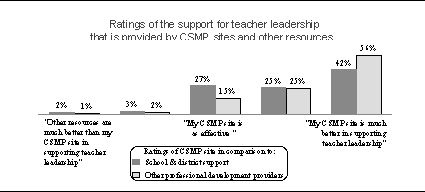
Summary and Final Thoughts
This study focused on gathering data from teacher leaders in order to understand more accurately the scale and scope of CSMP teacher leadership activities around the state. At the time this report is completed (June 1997), a second teacher leadership survey is being distributed by all 98 CSMP sites to their most active teacher leaders. This second survey will focus more closely on the nature of the interaction between classroom practice and teacher leadership, and, in particular, focus on the ways in which teacher leaders use assessment practices and information to inform their own teaching.
The study findings presented here are quite positive: they confirm the fact that CSMP sites are quite capable of supporting and deploying teacher leadership on a significant scale across the entire state. While the CSMPs should be justly proud of the work they are doing, the survey findings also pose questions that may help the CSMPs continue to build on and refine the foundation of teacher leadership they have already established:
- Why is there such large variation between sites and Projects in terms of the degree to which they are able to support and deploy large numbers of teacher leaders?
- What are the characteristics and approaches of the most successful sites?
- What ways do sites use to recruit new teacher leaders and, at the same time, provide ongoing opportunities for their most veteran teacher leaders?
- How do the activities that teacher leaders carry out in school and district-based workshops compare, in their nature and their quality, to the kinds of activities Projects are able to offer in their invitational institutes?
- How do teacher leader activities sponsored by the CSMPs support and/or contribute to other more local reform efforts such as school restructuring activities?
The CSMPs can rightfully be proud of the accomplishments outlined in these findings, but the questions listed above suggest that the CSMPs are also very much at a point where they can use their accomplishments as a basis for learning even more. If they can continue to learn from themselves and build upon their successes, the CSMPs will progress even further in their efforts to create, support and employ teacher leadership throughout the state.
Footnotes
1 In this case, 'active teacher leaders' were defined as teachers who: 1) had been actively involved with their site in the previous 12 months, or 2) may not have been actively involved with their site in the previous 12 months, but who nonetheless had played a strong and sustained role at the site in recent years.
2 1,206 of the teacher leaders indicated which site sent the survey to them.
3 Regional sites estimated that 44,352 individual teachers participated in 1994-95. Projects at the statewide level reported that they served 3,301 teachers. There is probably some small overlap between the two counts.
4 In 1995-96, there were 9,069 teacher leaders at regional sites. Comparable information is not available for the statewide Project activities.
5 Site Directors ordered a total of 3,052 surveys; we do not know how many were actually distributed.
6 The California Subject Matter Projects: A Summary of Evaluation Findings 1993 to 1996, December 1996. Inverness Research Associates; Inverness, CA.
7 "Highest-needs" districts include: 1) the 25 largest districts in the state, and 2) districts with more than 10,000 students that also meet at least two of the following criteria: among the 25 districts with the largest percentage of ELL/LEP students, students of color, and/or dropouts. Using these criteria, we identified 44 districts for special attention in this survey and in our annual site survey.
 
|
|
 |

